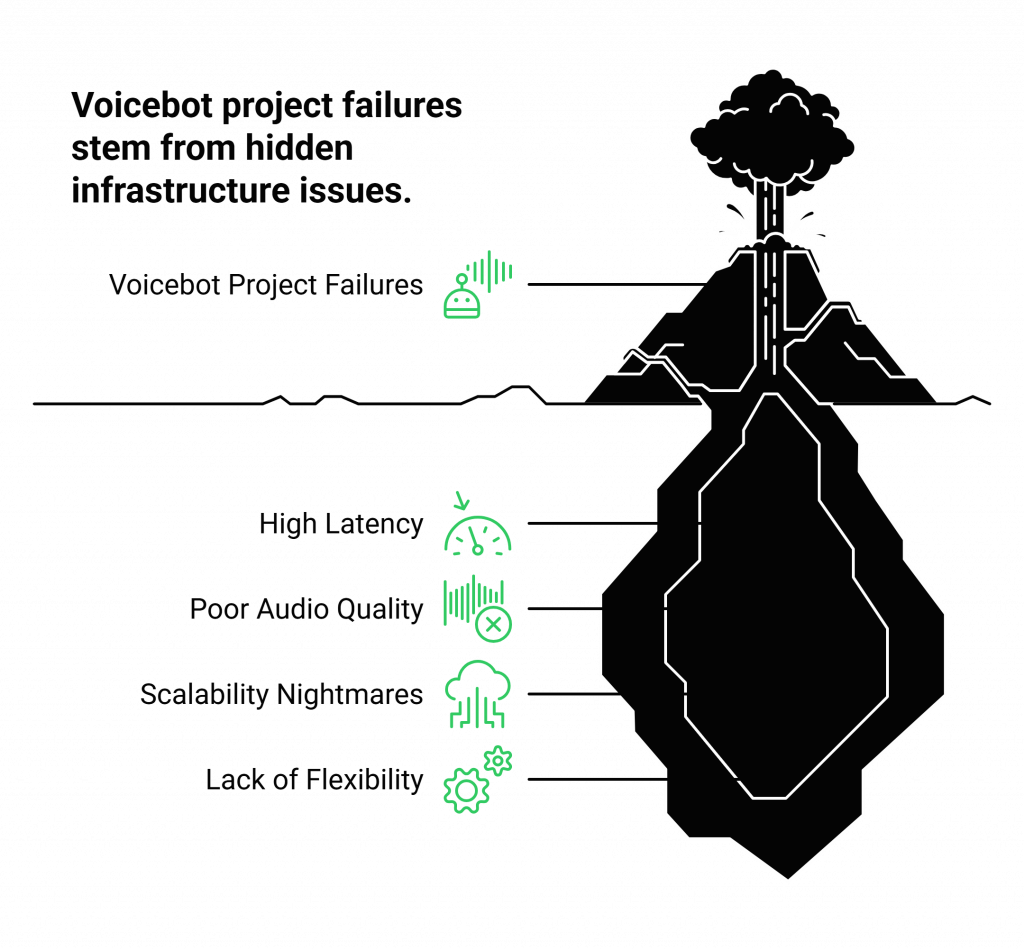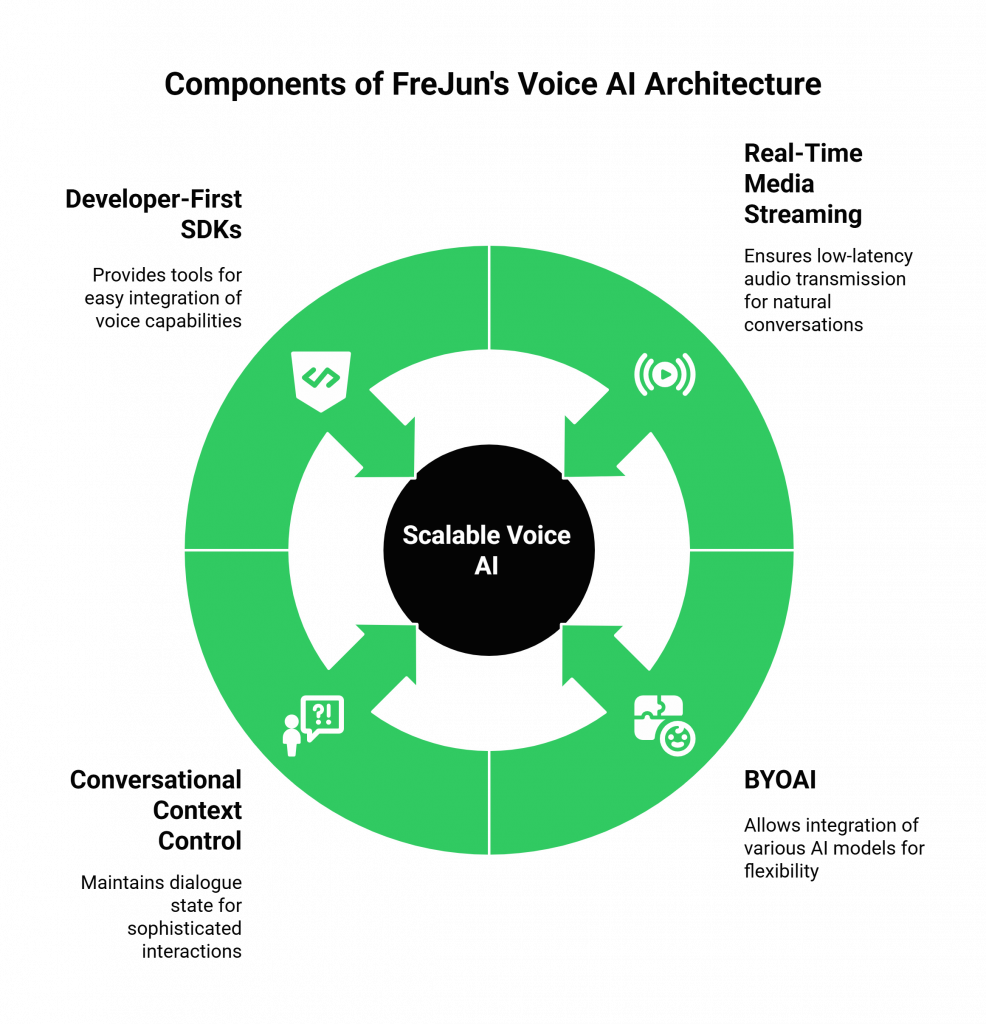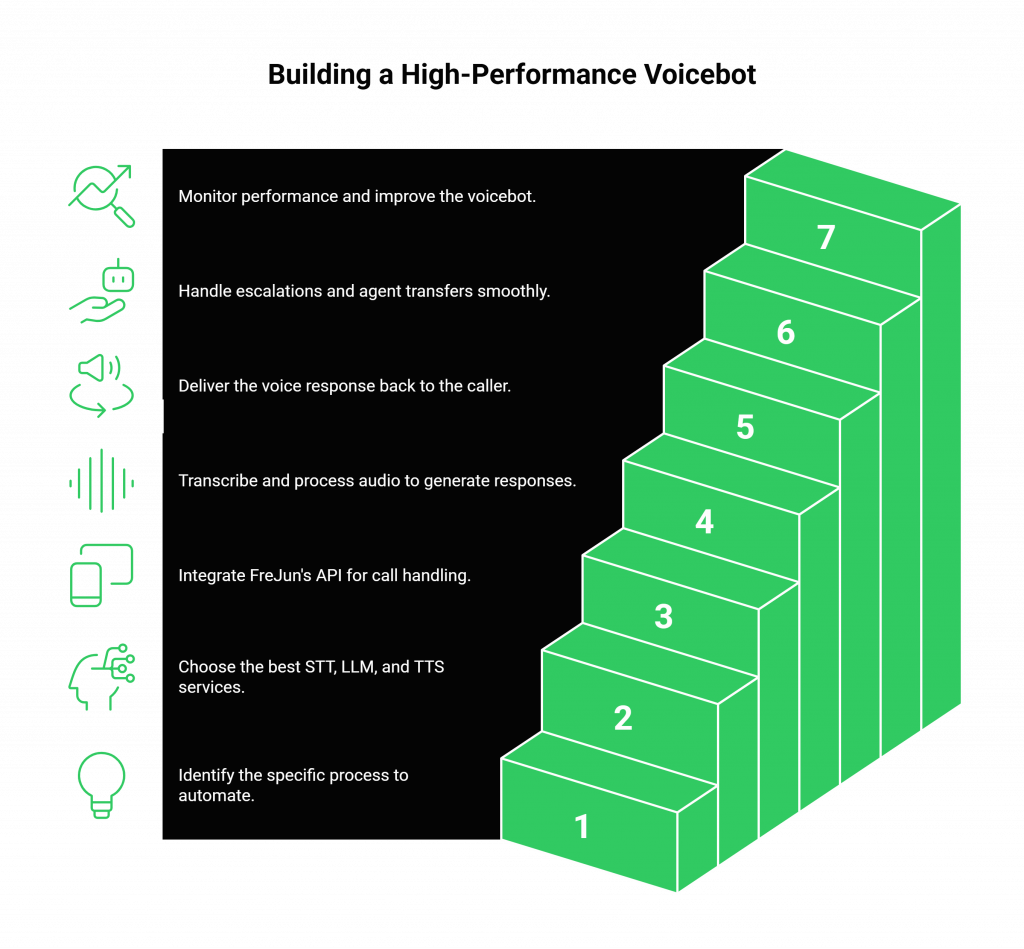Contact centers are racing to automate voice interactions, but most fail due to poor infrastructure, not bad AI. Real-time conversations demand more than a smart chatbot, they require low-latency voice streaming, telephony integration, and full control over your AI stack. That’s where FreJun’s Voicebot API comes in. FreJun gives you the high-performance voice transport layer to connect any AI model to real phone calls. In this guide, you’ll learn how to build scalable, production-grade voice automation using FreJun’s infrastructure.
Table of contents
- The Unfulfilled Promise of Contact Center Voice Automation
- Why Most Voicebot Projects Fail: The Hidden Infrastructure Problem?
- FreJun: The Infrastructure Layer for Production-Grade Voice AI
- Core Architecture: A Toolkit for Scalable Voice Applications
- FreJun’s Transport Layer vs. All-in-One Platforms: A Comparison
- How to Build a High-Performance Voicebot with FreJun’s Infrastructure?
- Final Thoughts: Build Your AI, Not Your Telephony Stack
- Frequently Asked Questions
The Unfulfilled Promise of Contact Center Voice Automation
Every contact center leader envisions a future of seamless automation: customers calling in, having their needs understood and resolved instantly by an intelligent voice agent, 24/7. This vision promises radical cost savings, improved first-contact resolution, and human agents freed up to handle the most complex, high-value interactions. The technology to power this vision,sophisticated AI and Large Language Models (LLMs),is more accessible than ever.
Yet, many businesses that attempt this transformation encounter a frustrating reality. Their voicebots sound stilted, suffer from awkward delays, and frequently misunderstand callers, leading to a broken customer experience. The culprit is rarely the AI model itself. The most common point of failure is the invisible, yet critical, foundation upon which the entire experience is built: the voice transport infrastructure.
Building a truly conversational AI requires more than just a smart brain; it needs a flawless nervous system capable of streaming voice data in real time without lag. This is where many projects stumble, and it’s the exact problem FreJun solves. We provide the robust voice infrastructure so you can focus on building brilliant AI.
Why Most Voicebot Projects Fail: The Hidden Infrastructure Problem?
To create a voicebot, you need to stitch together several complex technologies: a Speech-to-Text (STT) engine to transcribe the user’s speech, a Natural Language Processing (NLP) or LLM model to understand intent and generate a response, and a Text-to-Speech (TTS) service to vocalize that response. The collection of integrations that make this happen can be thought of as your conversational voicebot APIs.

However, the real challenge lies in getting the audio from the phone call to your AI stack and back to the caller in real time. This is a highly specialized engineering problem that most businesses are not equipped to handle.
The do-it-yourself approach or relying on all-in-one platforms with mediocre telephony backbones leads to several critical issues:
- High Latency: The delay between a caller finishing their sentence and the bot responding is the number one killer of conversational flow. Even a half-second of unnatural silence makes the interaction feel robotic and frustrating.
- Poor Audio Quality: Jitter, packet loss, and poor audio capture result in transcription errors by the STT engine. If the AI can’t hear the user clearly, it cannot respond correctly, leading to a loop of “I’m sorry, I didn’t get that.”
- Scalability Nightmares: An infrastructure built for a handful of test calls will buckle under the pressure of hundreds or thousands of concurrent calls during peak hours, leading to dropped calls and system failures.
- Lack of Flexibility: Many all-in-one solutions lock you into their proprietary, and often inferior, STT, NLP, and TTS models. As AI technology evolves, you are stuck with their outdated stack, unable to innovate or switch to best-in-class providers.
Also Read: Remote Team Communication Using Softphones for SMBs in India
FreJun: The Infrastructure Layer for Production-Grade Voice AI
FreJun takes a fundamentally different approach. We believe that you should have complete control over your AI logic and choose the best models for your use case. Our role is to be the premier voice transport layer that connects your AI to the global telephone network, flawlessly.
We are a model-agnostic platform. You bring your own AI,be it from Google, OpenAI, Microsoft, or a custom-built model. We provide the developer-first tooling and low-latency streaming infrastructure that makes it work in a real-world, real-time conversational setting.
Our architecture is designed from the ground up for speed and clarity. We manage the immense complexity of real-time media streaming, call management, and carrier interconnects. This frees your development team from having to become telephony experts and allows them to focus their energy on creating intelligent, context-aware conversational flows.
Core Architecture: A Toolkit for Scalable Voice Applications
FreJun provides everything you need to move from a concept to a production-grade voice AI that can handle enterprise-level call volumes. Our features are designed to give you maximum control over your AI while we manage the underlying complexity.

Real-Time, Low-Latency Media Streaming
This is the heart of FreJun. Our API captures audio from any inbound or outbound call and streams it to your application in real time. Our entire stack is optimized to minimize latency at every step: from the moment the user speaks, through your AI processing pipeline, and back to the user’s ear. This eliminates the awkward pauses that break conversational flow and make interactions feel unnatural.
Bring Your Own AI (BYOAI)
We don’t lock you into a specific AI model. Our API is model-agnostic, allowing you to connect to any STT, LLM, or TTS provider you choose. This gives you several key advantages:
- Control: You maintain full control over your AI logic and conversational design.
- Flexibility: You can mix and match best-in-class services (e.g., Google’s STT with OpenAI’s LLM and a specialized TTS voice).
- Future-Proofing: As AI technology evolves, you can easily swap out models without rebuilding your entire voice infrastructure.
Full Control Over Conversational Context
FreJun acts as a stable and reliable transport layer. We maintain the call connection while your application manages the dialogue state. This stable channel ensures your backend can reliably track and manage conversational context independently, allowing for sophisticated, multi-turn conversations without losing track of the user’s intent.
Developer-First SDKs
To accelerate your development, we provide comprehensive client-side and server-side SDKs. These tools make it easy to embed voice capabilities into your web or mobile applications and manage call logic on your backend. This dramatically reduces the time it takes to build and deploy your voice agent, turning a months-long project into a matter of days.
Also Read: US VoIP Number Implementation for International Trade in Saudi Arabia
FreJun’s Transport Layer vs. All-in-One Platforms: A Comparison
When deciding how to enable your contact center with voice automation, you have a choice. The table below compares the FreJun approach,providing a specialized infrastructure layer,against typical all-in-one voicebot platforms.
| Feature | Building on FreJun’s Transport Layer | Traditional All-in-One Voicebot Platforms |
| AI Model Flexibility | 100% Model-Agnostic. Connect any STT, LLM, and TTS provider. | Locked into proprietary, often mediocre, AI models. |
| Latency & Performance | Engineered for Low-Latency. Optimized for natural, real-time conversation. | Often suffers from noticeable lag, creating a poor user experience. |
| Developer Control | Full control over AI logic. Your application manages the conversation. | Limited control. “Black box” AI with minimal customization. |
| Infrastructure Focus | Your team focuses on building the AI and business logic. | Your team is forced to work within the platform’s limitations. |
| Scalability | Built on resilient, geographically distributed, enterprise-grade infrastructure. | Scalability can be a concern, with potential for dropped calls. |
| Cost Structure | Pay for the infrastructure you use and choose your own AI providers. | Bundled pricing that may hide the cost of inferior AI components. |
| Innovation Speed | Instantly adopt the latest AI advancements from any provider. | You must wait for the platform vendor to update their stack. |
How to Build a High-Performance Voicebot with FreJun’s Infrastructure?
Here is a step-by-step guide to building a sophisticated voice agent for your contact center, using FreJun as the foundational voice layer. This process highlights how you can leverage a set of best-in-class voicebot APIs to build your AI voicebot.

- Step 1: Define Your Primary Use Case: First, identify the process you want to automate. Common starting points include inbound customer support for FAQs, outbound appointment reminders, lead qualification calls, and more.
- Step 2: Select Your “AI Brain”: Choose the STT, LLM, and TTS services that best fit your needs and budget. You have the freedom to select from industry leaders like Google Cloud Speech-to-Text, OpenAI’s GPT models for conversational logic, and natural-sounding voices from providers like ElevenLabs or Google TTS.
- Step 3: Connect the Call with FreJun’s API: This is the core integration. When a call comes in, you use FreJun’s API to accept it. Our platform immediately begins streaming the raw, low-latency audio from the caller directly to your application’s endpoint.
- Step 4: Transcribe, Process, and Generate a Response: Your application takes the raw audio stream from FreJun and pipes it into your chosen STT service’s API. The STT returns a text transcription. You then send this text to your LLM API, along with the conversational history, to generate the appropriate text response.
- Step 5: Stream the Voice Response Back to the Caller: Your application sends the LLM’s text response to your chosen TTS service’s API, which generates an audio stream. You then pipe this audio stream directly back into the FreJun API, and we play it back to the caller in real time.
- Step 6: Manage Agent Handoffs and Escalations: Design your logic to recognize when the bot cannot resolve an issue. When a user asks to speak to a human, you can use FreJun’s API to seamlessly transfer the call to a live agent queue.
- Step 7: Test, Monitor, and Refine: Use analytics from both your AI provider and FreJun’s platform to monitor performance. Track metrics like task completion rates, conversation length, and escalation rates.
Also Read: CRM Calling vs. Traditional Calling: Which Delivers Better ROI?
Final Thoughts: Build Your AI, Not Your Telephony Stack
The goal of contact center automation is not just to replace human agents but to create efficient, satisfying, and scalable customer experiences. Achieving this with voice requires a flawless technical foundation. Forcing your development team to become experts in the arcane world of real-time voice streaming and telephony is a distraction from their primary goal: building intelligent applications.
FreJun provides the definitive answer to this challenge. We offer the specialized, high-performance voice transport layer that allows your custom-built AI to shine. By abstracting away the infrastructure complexity, we empower you to use the best AI models on the market and build truly conversational, production-grade voice agents in days, not months. Stop wrestling with latency and start building the future of customer interaction.
Get Started with FreJun AI Today!
Frequently Asked Questions
No. FreJun is a model-agnostic voice infrastructure platform. We provide the real-time, low-latency transport layer that connects your phone calls to the AI stack of your choice. You bring your own STT, LLM/NLP, and TTS services, giving you complete control and flexibility.
The primary benefits are flexibility, control, and performance. With FreJun, you are not locked into a proprietary AI stack and can choose best-in-class models. Most importantly, our infrastructure is engineered specifically for low-latency conversations, providing a more natural and responsive user experience than most bundled solutions.
FreJun’s API captures the audio from the live phone call and streams it in real time to an endpoint you control. Your application then forwards this audio stream to your chosen STT provider’s API for transcription. Our SDKs simplify this process.
Using separate, best-in-class Voicebot APIs allows you to optimize each component of your voice agent. You might find one provider has the most accurate transcription for your industry’s jargon, another has the best conversational AI, and a third offers the most natural-sounding voice. FreJun’s infrastructure enables this “best-of-breed” approach.
No. Our platform is designed for developers. With our comprehensive SDKs and clear API documentation, connecting your AI services to our voice transport layer is a straightforward process, significantly accelerating your time to deployment.
